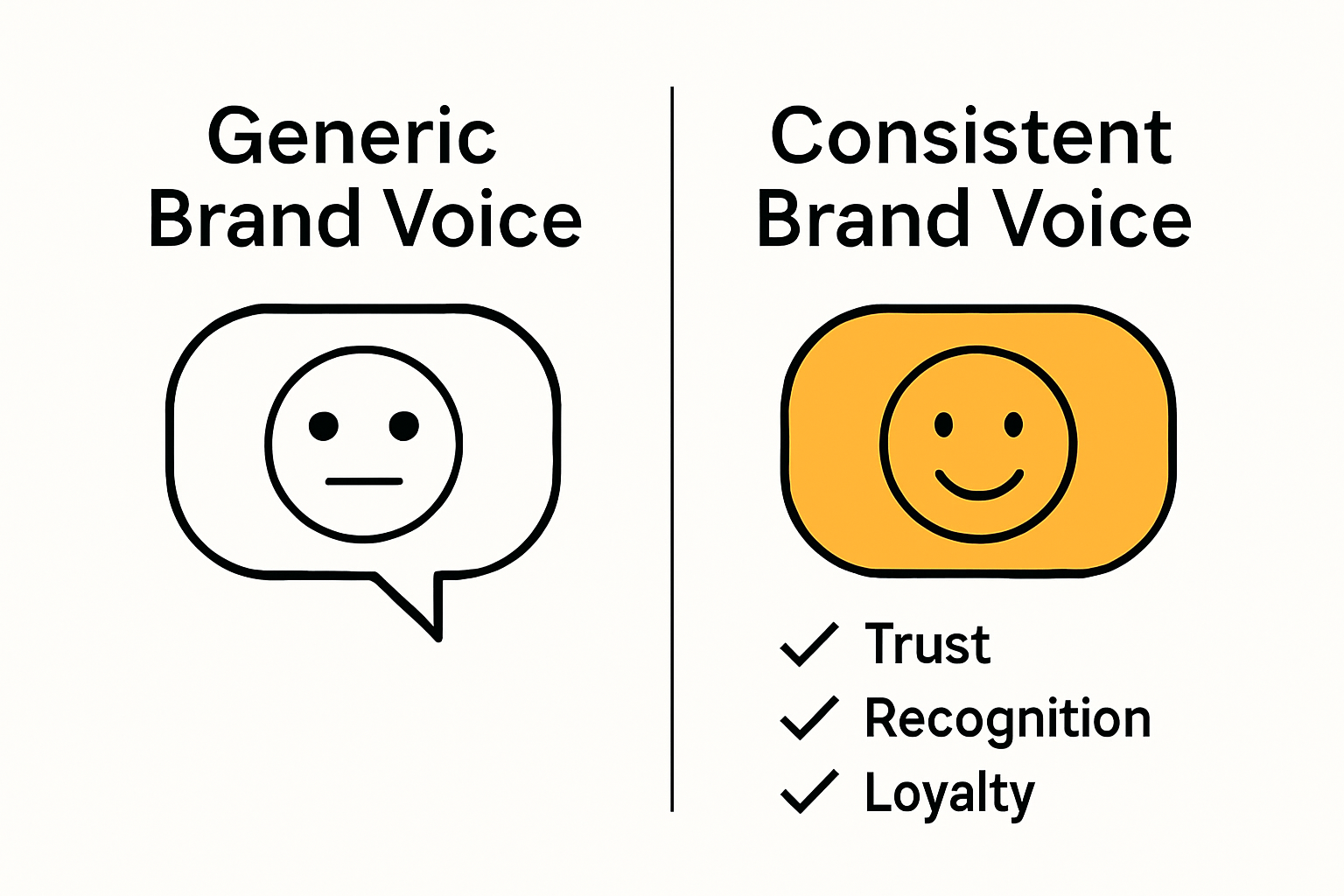Understanding the Importance of Brand Voice for eCommerce
Every brand sends a message, but only a few feel like they have an actual personality you want to connect with. Most ecommerce businesses focus on flashy visuals and clever slogans, yet research from Applied Sciences shows that the way a brand communicates can have a stronger impact on trust and buying decisions than product quality alone. So while design might catch the eye, it is the voice behind the words that turns shoppers into loyal fans.
Table of Contents
- Defining Brand Voice: What It Is And Its Elements
- The Role Of Brand Voice In Customer Connection
- Why Brand Voice Matters For Ecommerce Success
- How Brand Voice Influences Brand Perception
- Key Concepts In Developing A Consistent Brand Voice
Quick Summary
| Takeaway | Explanation |
|---|---|
| Define Your Brand Personality | Identify traits that represent your brand to establish a recognizable voice. |
| Maintain Consistent Language | Use uniform communication styles across all platforms to build a reliable identity. |
| Engage Emotionally with Customers | Create connections beyond transactions to foster loyalty and trust. |
| Align with Core Values | Ensure your communication reflects your brand’s mission and culture authentically. |
| Develop a Comprehensive Style Guide | Create guidelines to ensure every team member communicates in alignment with your brand voice. |
Defining Brand Voice: What It Is and Its Elements
Brand voice represents the distinct personality and emotional resonance a company communicates through its language, messaging, and communication style. Understanding the importance of brand voice goes beyond mere words it encompasses the entire character and emotional connection an ecommerce brand establishes with its audience.
Core Components of Brand Voice
A comprehensive brand voice consists of several critical elements that work together to create a cohesive and recognizable communication strategy. According to University of Maryland Extension, brand voice reflects the uniformity of words, attitude, and values while addressing the target audience.
The primary components include:
- Personality Traits: Defining the human characteristics that represent your brand
- Consistent Language: Maintaining a uniform communication style across all platforms
- Emotional Resonance: Creating a connection that goes beyond transactional interactions
Crafting an Authentic Brand Voice
Creating an authentic brand voice requires deep understanding of your brand’s core values and target audience. Take Action offers a comprehensive guide on understanding brand consistency that can help brands develop a more nuanced communication approach.
Authenticity emerges when brands align their communication style with their fundamental values. This means the language used should genuinely reflect the brand’s mission, culture, and unique selling propositions. For ecommerce brands, this translates into creating a voice that not only sells products but also builds trust and establishes a meaningful relationship with customers.
The process involves carefully selecting words, tone, and communication style that resonate with your specific audience while remaining true to your brand’s core identity. Whether your brand voice is professional, playful, compassionate, or bold, the key is maintaining consistency and genuine representation of your brand’s personality.
To clarify the essential building blocks of a brand voice, the following table summarizes its primary components and their brief descriptions.
| Component | Description |
|---|---|
| Personality Traits | Human characteristics that define how the brand is perceived |
| Consistent Language | Uniform style and tone used across all communication platforms |
| Emotional Resonance | The connection that goes beyond products to create meaning |
| Authenticity | Genuine reflection of brand values and mission |
| Empathy | Understanding and addressing customer perspectives |
| Reliability | Predictability and trustworthiness in every interaction |
The Role of Brand Voice in Customer Connection
Customer connection represents the emotional and psychological bridge between an ecommerce brand and its audience. A well-crafted brand voice serves as the primary mechanism for establishing and maintaining this critical relationship, transforming transactional interactions into meaningful experiences.
Emotional Engagement Through Communication
Brand voice acts as a powerful tool for emotional engagement, allowing ecommerce brands to communicate beyond product specifications and pricing. According to research from Frontiers in Psychology, a positive online customer experience significantly enhances relationship quality and fosters brand loyalty.
Key elements of emotional connection include:
- Authenticity: Communicating genuine brand values
- Empathy: Understanding and reflecting customer perspectives
- Consistency: Maintaining a uniform communication approach
Building Trust Through Predictable Communication
Trust emerges when customers can predict and relate to a brand’s communication style. Take Action offers insights on maintaining brand consistency that help businesses create reliable communication frameworks.
Customers subconsciously evaluate brands based on how they communicate. A consistent brand voice signals professionalism, reliability, and commitment. When an ecommerce brand speaks with a clear, recognizable personality, it transforms from a faceless digital entity into a relatable partner in the customer’s journey.
Ultimately, brand voice is not just about what you say, but how you say it. It represents a strategic approach to building lasting connections, turning casual browsers into loyal advocates who feel personally aligned with your brand’s mission and values.
Why Brand Voice Matters for eCommerce Success
In the crowded digital marketplace, brand voice emerges as a critical differentiator that can significantly impact an ecommerce brand’s ability to attract, engage, and retain customers. More than a communication strategy, brand voice represents a strategic asset that directly influences customer perception and purchasing behavior.
Competitive Differentiation in Digital Spaces
Standing out in the digital landscape requires more than competitive pricing or product quality. According to research from Applied Sciences, the way brands communicate can dramatically influence consumer trust and purchase intentions. A distinctive brand voice helps ecommerce businesses cut through the noise and create memorable interactions.
Key competitive advantages include:
- Unique Positioning: Establishing a memorable brand personality
- Customer Recognition: Creating instant brand identification
- Emotional Connection: Developing deeper relationships beyond transactions
Driving Customer Loyalty and Retention
Customer loyalty is not an accident but a strategic outcome of consistent and compelling communication. Take Action provides comprehensive insights on maintaining brand consistency that can transform casual shoppers into dedicated brand advocates.
A well-crafted brand voice communicates reliability, builds trust, and creates an emotional framework that encourages repeat purchases.
 When customers feel a genuine connection with a brand’s communication style, they are more likely to choose that brand repeatedly, even when alternative options exist.
When customers feel a genuine connection with a brand’s communication style, they are more likely to choose that brand repeatedly, even when alternative options exist.

Ultimately, brand voice in ecommerce is about creating a holistic experience that extends far beyond the transactional moment. It transforms digital interactions from mere purchases into meaningful, personalized journeys that resonate with customers on a deeper, more emotional level.
How Brand Voice Influences Brand Perception
Brand perception extends far beyond visual aesthetics or product quality. It is a complex psychological construct fundamentally shaped by how a brand communicates, with brand voice serving as the primary mechanism for crafting consumer impressions and emotional connections.
Psychological Foundations of Communication
Consumers subconsciously evaluate brands through their communication style. According to research from the International Journal of Communication, brands employing a casual, human tone are more likely to generate positive consumer perceptions and engagement compared to traditional corporate communication approaches.
Key psychological triggers include:
- Relatability: Creating a sense of human connection
- Authenticity: Demonstrating genuine brand personality
- Emotional Resonance: Triggering meaningful psychological responses
Shaping Consumer Trust and Expectations
Take Action offers insights on maintaining brand consistency that help businesses understand the nuanced relationship between communication and consumer trust.
Every interaction becomes an opportunity to reinforce or reshape brand perception. When a brand consistently communicates with clarity, empathy, and alignment with its core values, consumers develop a more positive and trusting view of the organization. This perception transcends individual transactions, creating a holistic understanding of the brand’s character and reliability.
For a quick overview of the psychological effects that brand voice can generate, the table below outlines key psychological triggers and their roles in shaping brand perception.
| Psychological Trigger | Role in Brand Perception |
|---|---|
| Relatability | Fosters human connection, making the brand feel accessible |
| Authenticity | Builds credibility and long-term trust |
| Emotional Resonance | Evokes strong emotional responses leading to loyalty |
| Clarity | Reduces confusion and establishes the brand as dependable |
| Empathy | Signals understanding and alignment with customer needs |
Ultimately, brand voice acts as a strategic instrument for transforming abstract brand attributes into tangible, relatable experiences that resonate deeply with target audiences. By carefully crafting communication that reflects genuine personality and values, ecommerce brands can significantly influence how consumers perceive and interact with their business.
Key Concepts in Developing a Consistent Brand Voice
Developing a consistent brand voice requires strategic planning and deliberate execution. It is more than selecting words randomly it involves creating a comprehensive communication framework that reflects the brand’s core identity, values, and unique personality across all digital touchpoints.
Foundational Elements of Brand Voice
According to research from Cal Poly’s Small Business Development Center, establishing a brand voice begins with understanding fundamental components that distinguish your communication strategy.
Critical foundational elements include:
- Target Audience Understanding: Deeply comprehending audience demographics and communication preferences
- Brand Personality Definition: Articulating clear personality traits that represent the brand
- Communication Style Alignment: Matching voice to brand values and audience expectations
Strategic Voice Development Process
Take Action provides comprehensive insights on maintaining brand consistency that can help businesses refine their communication approach.
The strategic voice development process involves creating a detailed style guide that outlines specific communication parameters. This guide serves as a blueprint for maintaining consistency, ensuring that every team member understands how to represent the brand’s personality across different channels and interactions.
Effective brand voice development transcends simple language guidelines. It requires ongoing refinement, active listening to audience feedback, and a commitment to authentically representing the brand’s core identity through every communication touchpoint. By treating brand voice as a dynamic, evolving strategy, ecommerce businesses can create more meaningful and resonant connections with their target audience.
Turn Your Unique Brand Voice Into Real eCommerce Growth
Your brand voice is more than words. It is trusted, emotional connection that sets you apart from countless competitors. The article showed how a clear, consistent voice can win loyalty and drive sales. But bringing that to life in your daily email marketing is a real challenge. Maybe you struggle to align automated messages with your true brand personality. Or perhaps your abandoned cart flows and campaign emails feel generic, risking trust and missed revenue.
Imagine if every customer email—from welcome to post-purchase—sounded just like you and converted better.

Ready to make your brand voice a powerful growth channel? Partner with our team at Take Action. We are experts in blending human creativity with data-driven Klaviyo automation. See how we can help you establish a holistic, stand-out presence across every inbox. Move beyond templates to true retention with the right campaign strategy and flows. Take the first step toward stronger engagement and measurable revenue gains. Visit https://take-action.agency now and let us elevate your brand voice into lasting customer relationships. Don’t settle for forgettable emails—deliver consistent value and stand out every time you hit send.
Frequently Asked Questions
What is brand voice in eCommerce?
Brand voice in eCommerce refers to the distinct personality and emotional resonance that a brand communicates through its language, messaging, and overall communication style. It encompasses how a brand expresses its values and connects emotionally with its audience.
Why is brand voice important for customer engagement?
Brand voice is crucial for customer engagement because it helps create an emotional connection between the brand and its audience. A well-defined and authentic brand voice can transform transactional interactions into meaningful experiences, fostering brand loyalty and trust.
How can a brand maintain a consistent voice across multiple platforms?
To maintain a consistent brand voice across multiple platforms, businesses should develop a comprehensive style guide. This guide should outline the brand’s key personality traits, language style, and communication strategies, ensuring that all team members communicate in a unified manner.
What are the core components of a brand voice?
The core components of a brand voice include personality traits that define the brand, consistent language used across different platforms, and emotional resonance that connects with the target audience. These elements work together to create a cohesive communication strategy.
